The birth and development of optic fiber communication is an important revolution in the history of telecommunications.

In 3G network construction, FTTH (optical fiber to the home) implementation, triple fusion pilot, western coverage project, “light into copper” and other multiple positive drives, China’s optic fiber cable industry development momenta are good.
China has become the world’s main optic fiber cable market and the world’s largest optic fiber cable manufacturer and has made remarkable achievements.
In 2011, there were 149 enterprises above the designated size in the Chinese optical fiber and cable industry, with 21 less than the previous year; total industrial output value was RMB 68.802 billion; sales revenue was RMB 64.31 billion yuan, up 24.68% year on year; profit was RMB 6.554 billion, up 47.39% year on year.
With the adoption of FTTH and FTTC systems in China, the integration of three networks, and large-scale 3G construction, the market demand for optical fiber and cable is still very large, which provides a strong impetus for the development of China’s optical fiber and cable industry, and the industry has a good prospect.

With the increasing competition in the optical fiber and cable industry, mergers and acquisitions and capital operations among large optical fiber cable enterprises are becoming more and more frequent.
The domestic excellent optical fiber and cable production enterprises pay more and more attention to the research of the industry market, especially the in-depth study of the trend of enterprise development environment and customer demand.
Because of this, a large number of domestic excellent domestic optical fiber and cable brands rose rapidly, gradually become the leader in the optical fiber and cable industry.
The birth and development of optical fiber communication is an important revolution in the history of telecommunications.
The informatization construction of human society is accelerating, and even in the sluggish global economy, the communication and information industry is still very popular.
Optical fiber communication is developing in the direction of high-speed, ultra-high-speed, ultra-large-capacity optical fiber transmission and all-optical network.
In the process of realizing informatization in my country, China Telecom completed the laying of optical cable trunk lines of “eight vertical and eight horizontal” during the “Ninth Five-Year Plan” period.
A backbone communication network with optical cable as the main body is gradually formed. The high-capacity optical cable trunk extending in all directions has become my country’s “information channel”.

With the continuous development of the communication industry, optical cables have been laid from provinces to cities, counties and even townships. The date of “fiber to the home” is getting closer.
In recent years, with the advancement of technology, the reform of the telecommunications system and the gradual opening of the telecommunications market.
The huge demand for bandwidth brought about by the explosive development of IP services, the development of optical fiber communications has once again shown a booming development.
Fiberglass has been used to transmit light for over 30 years.
Initial fiber optic applications were limited to certain optomechanical and medical devices (such as light guides and gastroscopes), which transmitted visible light with an attenuation of up to 1000 dB/km.
In 1966, Dr. Gao first proposed the idea of using quartz-based optical fiber for long-distance optical information transmission.
In 1970, the chemical vapor deposition system was developed in the United States, which was attenuated to 20dB/km, thus making long-distance transmission a reality.
Subsequently, the attenuation of the optical fiber declined rapidly, dropping to the theoretical limit level of 0.2 dB / km by the late 1970s.

The bandwidth of optical fiber is increasing, and by the early 1980s, single-mode fiber with a bandwidth of hundreds of GHz kilometers was available.
An optical fiber optic communication system with a relay distance of more than 100 kilometers and a capacity of hundreds of Mits /s has been developed.
Fiber-optic communication equipment manufacturing has evolved into an emerging industrial sector.
The characteristics of optical wave intensity and phase in optical fiber that change with different physical quantity, including temperature, electric field and magnetic field, has been used in highly sensitive telemetry sensors.
The development history of China’s optical fibers also confirms the scale and speed of China’s optical fiber manufacturing industry.
Therefore, the optical fibers made in China are also of excellent quality and are worthy of everyone’s trust.